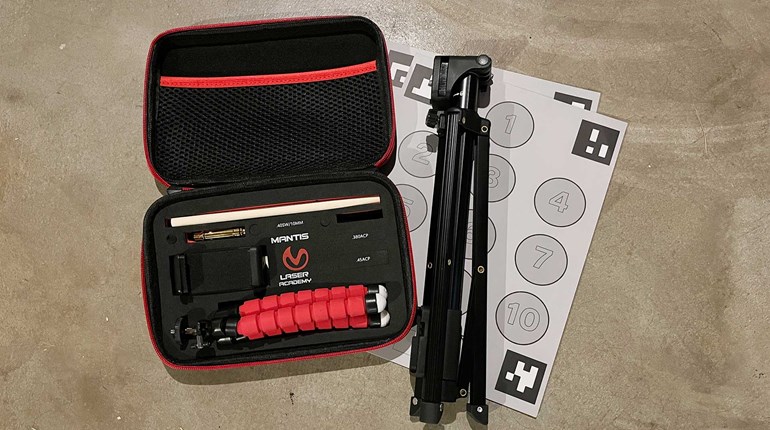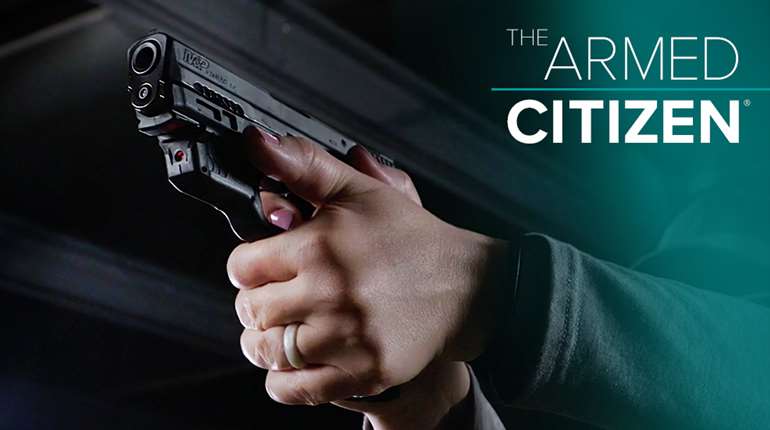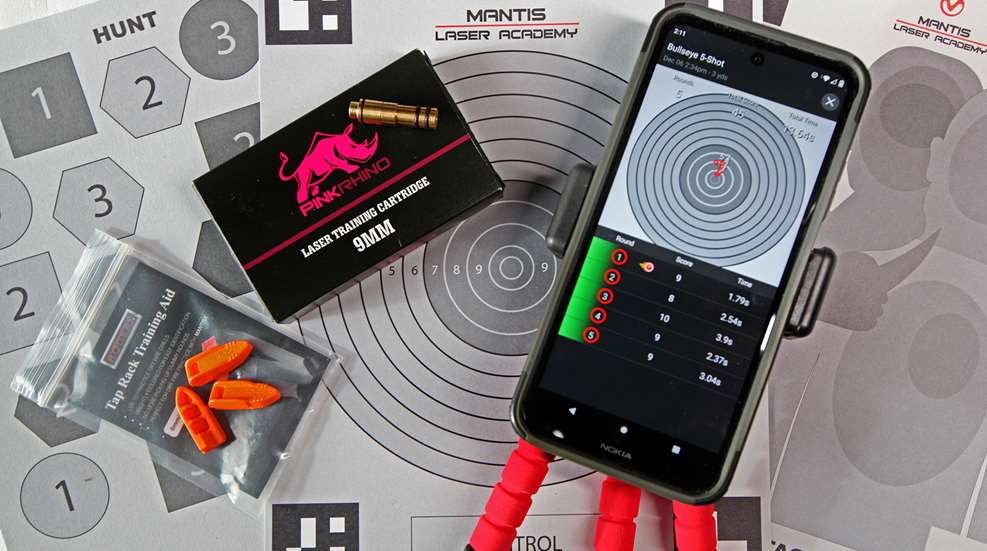
To be “skilled” in something is defined as having the ability to do it well; exhibiting competence, proficiency and knowledge in the activity. Through practice and training, you can achieve a high level of skill in handling and shooting firearms. The cost of ammo, range fees and gas for transportation, however make training an expensive endeavor and subsequently something you may not do very often.
One of the most convenient forms of firearms practice is “dry fire.” You can do this type of training at home with your unloaded firearm, including practicing drawing from concealment, and develop your basic shooting fundamentals. But dry fire is still one step removed from firing live rounds on a range and getting real-world feedback on your accuracy. Think about your self-defense gun handling skills as if they were driving skills. You have a car parked in the garage ready to go with a full tank of gas. Years go by and you never drive it. Then in an emergency you need to jump in it and go somewhere in a hurry. Is it a key start or push-button start? Does the seatbelt need to be buckled or the brake depressed before shifting out of park? Is the back-up camera working or maybe you have to rely on mirrors? And since it’s an emergency you need to do all of these things quickly and under stress. If you carry your handgun for protection, but don’t shoot often, you can run into the same problems of lacking speed and proficiency when you need it most.
Mantis Tech is a company that offers three different technology-based firearms training systems. Its Laser Academy system utilizes “smart targets,” an app on your phone and a laser cartridge to allow you to record and quantify your accuracy and build speed with dry fire drills in the comfort of your home. Its MantisX system combines a firearm-mounted sensor and an app on your phone to trace your grip hold, trigger press and follow-through. It uses this data to analyze your movement with each shot and offer suggestions on how to improve your technique, during both dry and live fire training. The third training system, called Blackbeard, is designed exclusively for the AR-15 platform (it won the American Rifleman Golden Bullseye Accessory of the Year award for 2022). In this review we’ll cover the Laser Academy and MantisX systems.
The Mantis Laser Academy
Before using the Laser Academy system, you will first need to install the app on your smartphone or tablet. The Academy kit comes with 12 different paper “smart” targets. After determining a safe area to conduct the training, these can be taped to the wall or placed in the supplied target stands. You phone goes into a holder on a tripod and is positioned so that the camera can “read” the targets. The Academy app utilizes your phone’s camera to record your laser hits on the target. Verify the pistol you are going to train with is empty and insert the laser cartridge into the chamber. Laser cartridges are offered in 9 mm, .40 S&W, .45 Auto, .380 Auto, .38 Spl./.357 Mag, and .223/5.56. Several drills are offered for free with the Laser Academy. If you want more advanced training, you’ll have to invest in a Laser Academy online subscription to unlock the advanced drills and the targets associated with them. The subscription is included if you purchase your training tools as a complete kit.
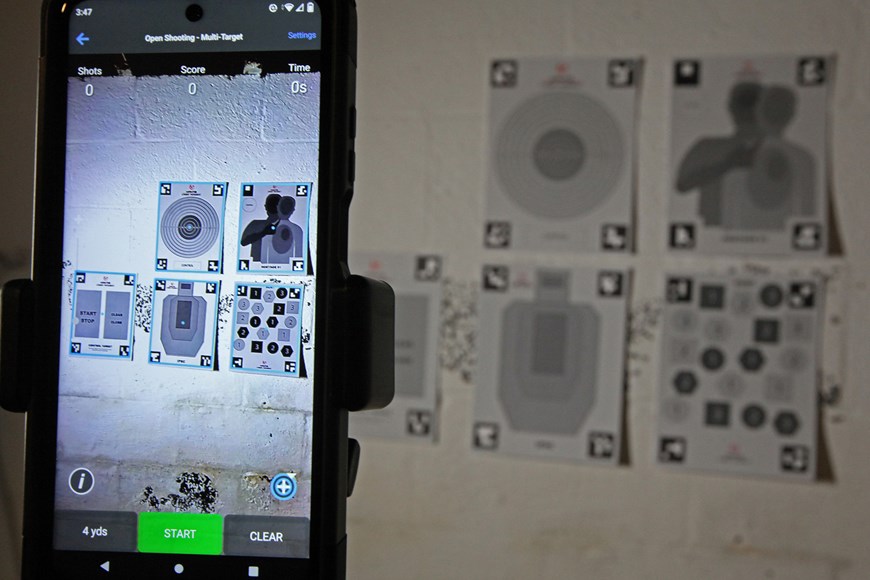
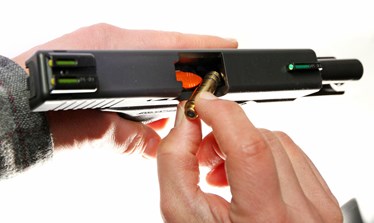
The Laser Academy app has tutorials that will familiarize you with the system before you get started with the drills and marksmanship courses. When you choose a drill on the app, it will tell you the goal of the drill and which targets you will need. The app audibly directs the starts and stops for the drills, like a competition shot timer. A variety of different training targets test your skills. For example, one drill calls out a specific shape that you must identify and shoot on the target, another deals with simulating malfunctions, and one utilizes a hostage target for a timed challenge.
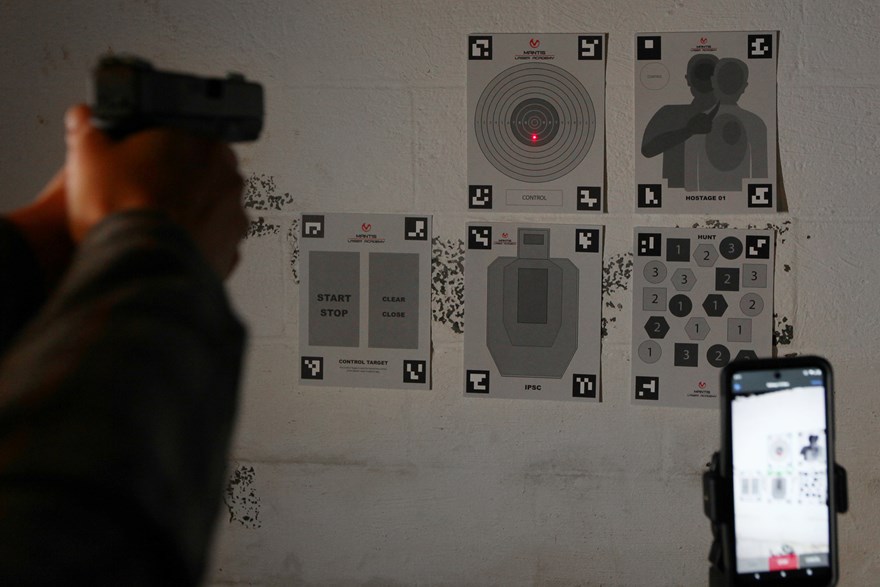
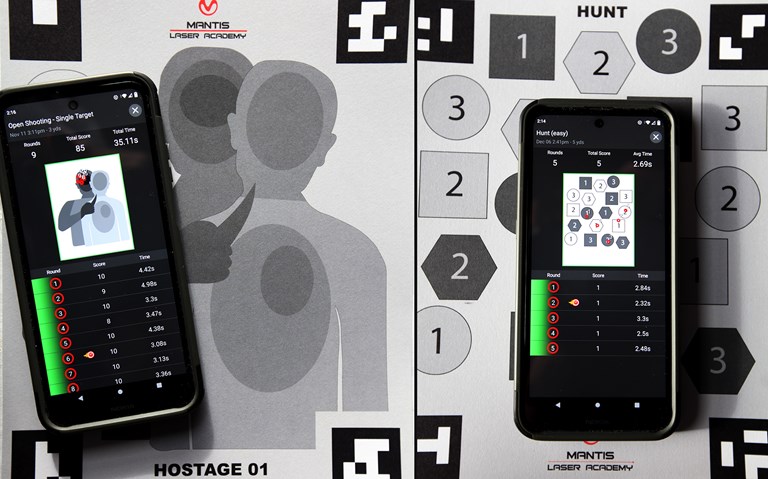
At the completion of each session, you can review your target on the app. The app will show your marksmanship, how quickly you make your shots, and keep track of your progress. When you’re done with training, you can use the supplied extraction rod or a pencil to push the laser cartridge out of the chamber.
The MantisX Training System
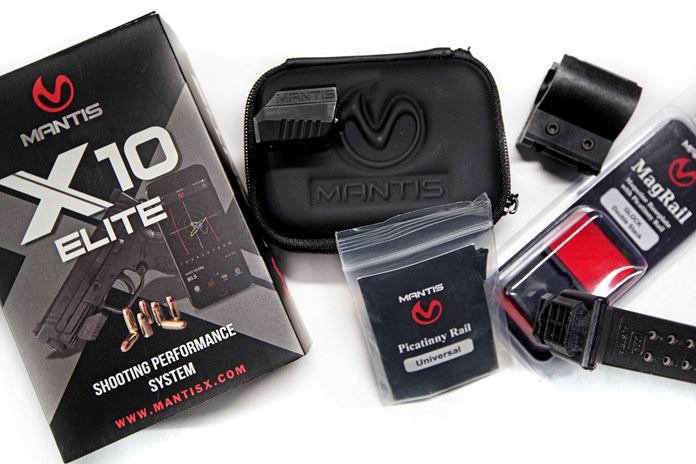
The MantisX training system is offered with different sensor options: the X2—dry fire practice only for pistols and rifles; the X3—dry- and live-fire practice for pistols and rifles; X7—dry and live fire for shotgun shooters; X8—archery practice; and the X10 Elite—dry and live fire practice for pistols, rifles, shotguns and bows. We tested the X10 Elite sensor, which also allows for analysis of recoil management and your holster draw technique.
The Mantis X10 sensor can be used on any firearm. If your firearm has a standard slotted accessory rail the sensor will mount directly on it. If not, Mantis offers a number of different magazine rail adapters which replace the floor plate on your pistol’s magazine and have a small section of rail for the sensor to attach (they also offer a universal magazine adapter that adheres to the floor plate). The magazine rail mount is what you will need if you want to practice drawing from a holster that doesn’t accommodate mounted accessories. The mag rail mount also allows you to use the Mantis system with the accessory light or laser you normally use on your handgun attached. The X10 kit comes with a rail adapter that clamps to a rifle or shotgun barrel.

If you plan to practice with a revolver that doesn’t have a built-in rail, then you will have to get one of the Mantis BoreRail adapters that fit in the muzzle of the barrel to give you a rail section for the sensor to mount to. This obviously only allows for dry fire practice with the sensor.
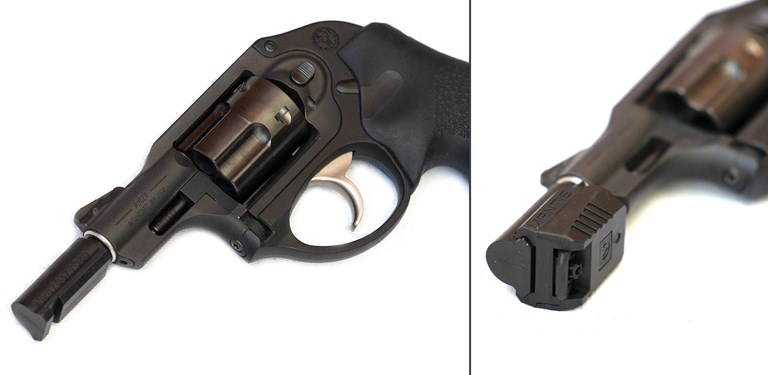
Image courtesy MantisTech
To set up your training, the app needs you to specify the type of firearm you are using and whether you are doing dry-fire or live-fire practice so the sensor can configure to appropriate settings. Upon firing, the app will instantly display data charts that give an analysis of your technique. The “shot chart” shows how steady your overall aiming and firing process was, approximating where your hits would be if you were shooting at a target. The MantisX system will diagnose problems and give you tips for improving.
The next two charts are graphs that show your individual shot scores so the shooter can judge their consistency and how much movement your grip and trigger press had in the moment before the shot broke.
The final chart displays a line tracing your arc of movement for each shot. Different colored lines indicate your hold before you begin to press the trigger, your trigger press and movement after the trigger breaks. There is a “Play” button that allows you to watch the pattern of your movement as you made the shot.
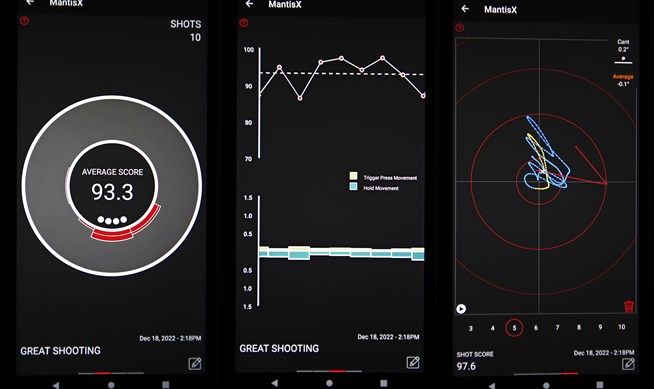
The holster draw analysis is unique to the X10 sensor and has a different set of charts, showing the time it takes for your hand to grip the handgun after the start beep, the draw from the holster until the firearm reaches horizontal and finally your aim and trigger pull. Each draw has a movement trace line chart and a color bar chart to visually quantify time. You can use this drill to practice your different methods of concealed carry and see how your draw times measure up.
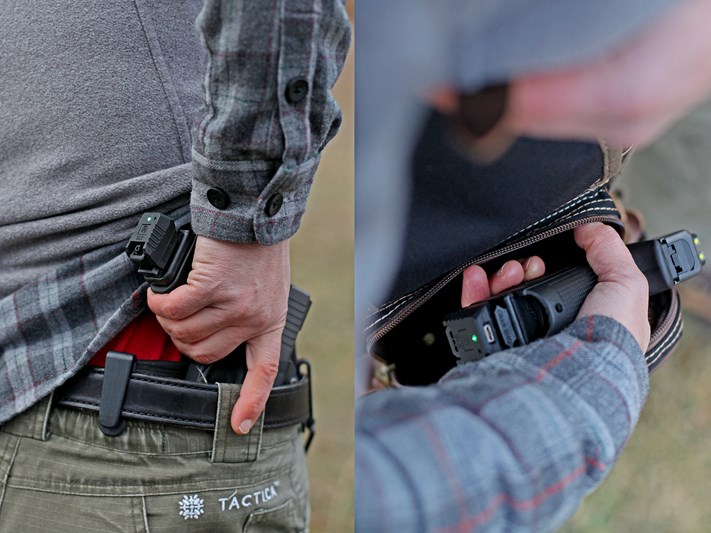
After doing some indoor dry-fire practice with the X10 sensor, I took it out for some live-fire testing. With dry-fire practice, the X10 sensor is only analyzing the movement and speed of your shooting fundamentals. When live firing with the MantisX, your hits on the target are real-world feedback for how well you’re following the system’s recommendations. When doing live fire training, I found it helpful to have another person read out my aiming scores or verbally relay the Mantis suggestions so that I could stay focused on my shooting fundamentals.
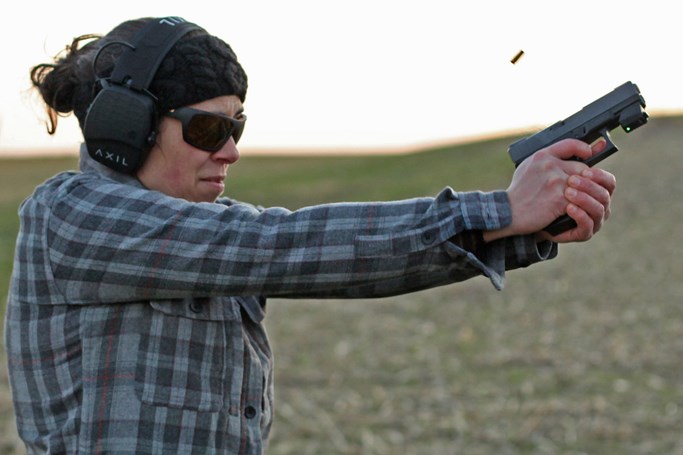
In a live-fire training session, the X10 sensor has a recoil meter to measure recoil in one of the app’s drills. The sensor records in degrees the muzzle rise of the firearm and how quickly you get back on target. You can play around with things like changing your grip, shooting +P ammunition or adding a rail-mounted light to see how that affects muzzle rise and your ability to manage recoil.
To test the X10 sensor on a rifle, I used the barrel clamp to mount the sensor. My test subject was a beginning hunter. We first tested his trigger control with some dry fire practice. Once the system showed he had the fundamentals, we started some live fire drills with the X10 on a .22 LR rifle before stepping up to a high-powered hunting rifle to better analyze his hold, trigger press and recoil management. His accuracy on the paper target confirmed what the data charts were telling us was happening when he fired. For an instructor, the MantisX system allows you to pick up on and correct technique problems faster than just observation with the naked eye.
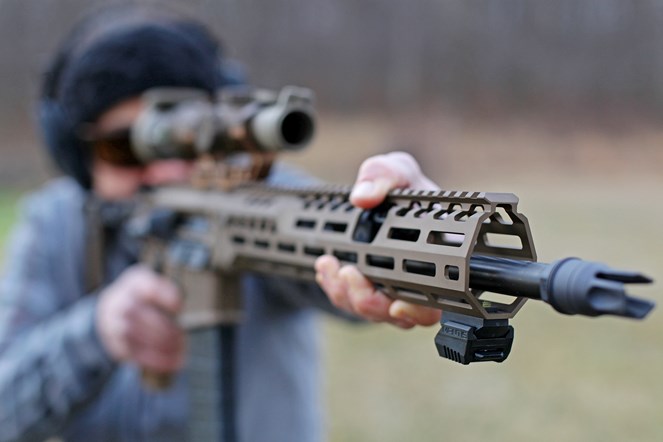
A benefit of the MantisX system is that you can instantly learn from your mistakes. Whether on the range or doing dry fire practice the Mantis gives you feedback so that you can make changes shot-by-shot. I even tried simulating bad shooting techniques that I have seen beginning shooters have—too firm of a grip, too much trigger finger, flinching—and the Mantis sensor picked up on and diagnosed the problems in real time.
The Mantis store offers many accessories that make using their training system easier. One is the Roger Tap Rack Training Aid, an adapter that keeps the follower of your magazine depressed so that it does not lock your slide when you rack it. This allows those with striker-fired handguns to reset their trigger with an empty magazine in place during dry fire practice.
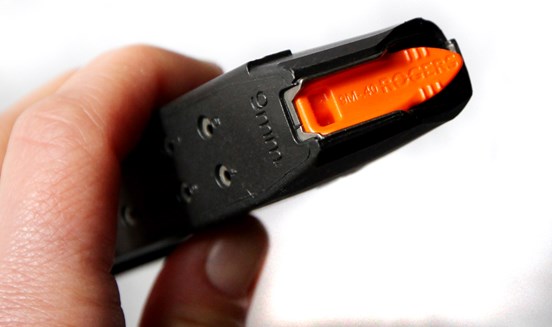
One of the best features of the MantisX system is that your shooting sessions and drill scores are saved in the app, like a fitness tracker, allowing you to go back and review your progress. You can also complete app-based marksmanship courses, which lead you through different drills. Another feature that encourages training is a daily challenge that you can complete each time you open the app. If you choose to, you can join online training groups so that you can train and compete remotely with others.
While you could use both the Laser Academy and MantisX systems simultaneously, you would need two separate devices with each one running the different apps. With so many different features and drills it’s worth taking the time to read through the instruction guide online or on the app. Mantis also has many online instructional videos to aid in setting up the system.
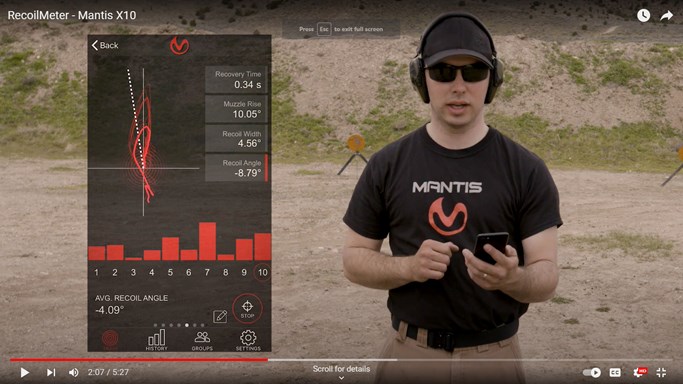
Image courtesy MantisTech
MantisX sensors come with a USB charging cable and a fully-charged sensor should last about 20 hours. The Laser Academy laser cartridge takes three LR626 batteries, which are included. The Laser Academy standard kit costs $149, and the X10 Elite training system retails for $249. The basic X2 sensor is $99.
Mantis systems are designed to help all shooters, from beginners to seasoned competitors. The company states their mission is to “Improve every shooter at every level.” The Mantis systems bridge the gap between traditional dry fire practice and using live ammunition on a range. Once on the range, the MantisX sensors continue to analyze your shooting performance. As a “virtual instructor,” it takes the guess work out of how to improve your firearms skills.













